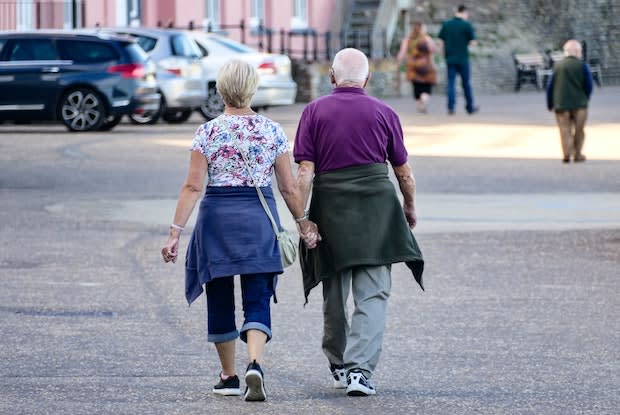Table of Contents
I. What is Physical Activity vs. Exercise?
II. Different Types of Exercise
III. Exercise Recommendations for Older Adults
V. Familial Hypercholesterolemia and Zetia
What is Physical Activity vs. Exercise?
Exercise is essential to keep our bodies healthy and our minds young. A variety of movements and exercises keep the body fit, agile, and balanced as we age. Four different kinds of exercise include endurance (or aerobic), strength, balance, and stretching.
It’s helpful to find exercises that you enjoy, and to understand our movement capabilities may change as we get older. If you are recovering from an injury, a cardiac event or stroke, or have a chronic medical condition, there are many ways to modify exercise so that it is accessible for you. Along with exercise, medications like Zetia can help improve daily function.
As defined by the World Health Organization (WHO), physical activity is any bodily movement produced by skeletal muscles that require energy expenditure. Moreover, a lack of exercise (physical inactivity) is the fourth leading risk factor for death worldwide, at a staggering six percent of deaths globally. Physical inactivity is estimated to be the leading cause of around 30 percent of heart disease burden as well. Physical activity includes exercise, yard work, house chores, walking the dog, and playing outside. [1]
Get savings updates for Zetia
But, the term physical activity should not be mistaken for the word exercise. You can think of physical activity as an umbrella term and exercise as a subcategory under that umbrella. The WHO defines exercise as a physical activity that is planned, structured, repetitive, and purposeful with physical fitness as the objective. Exercise makes you work up a sweat, breathe more heavily and increases the heart rate.
Peter Zeblisky, Doctor and contributor to the Cleveland Clinic health blog, agrees that although house chores and yard work are important things to keep us active, these activities don't necessarily constitute as medically recommended exercise. For a 40-year-old, moderate exercise should raise and maintain your heart rate to 50-70 percent of your maximal range (a heart rate in the 90-126 range).

Different Types of Exercise
It's important to engage in a range of exercise types to access maximum benefits. We tend to stick to ways of moving that feel familiar or comfortable, but trying something new and out of your comfort zone helps you to learn, grow, and keep exercise fun. We should be doing a combination of aerobics, strengthening, stretching, and balance exercise to ensure certain areas of activity don’t go ignored.
Aerobic Exercise
Aerobic exercise is a form of cardiovascular conditioning where the term aerobic means "with oxygen." Aerobic exercise speeds up the heart rate and breathing and increases endurance and capacity of the heart, lungs, and circulatory system. Over the long term and combined with weight loss, aerobic exercise reduces your risk of type 2 diabetes, heart disease, breast and colon cancer, depression, and falls. [2]
Aerobic exercise also helps to:
- Relax blood vessel walls
- Lower blood pressure
- Burn body fat
- Lower blood sugar
- Reduce inflammation
- Boost mood
- Lower bad LDL cholesterol
- Raise good HDL cholesterol
When we perform aerobic exercises, a continuous supply of oxygen is produced to sustain the activity without stealing energy from elsewhere. Because aerobic exercise produces oxygen, which is required for the body to use fat as fuel, this type of exercise may use a combination of fat and glucose for fuel. [3]
Forms of movement that are considered aerobic exercise include jogging, walking, or cycling at a steady pace, swimming, aerobic dance, or using the stair climber or elliptical machines at a gym. There are a ton of free home workout video options all over the internet that you can do from the comfort of your living room. Give one a try and see how you feel.
Strength Training
Anaerobic exercise, such as strength training, means “without oxygen” and can only use glucose for fuel. Glucose is available in the muscles to be used for quick, short, intense bursts of movement. When the aerobic system is fatigued, the body’s anaerobic capacity kicks in.
During high-intensity bursts of exercise, oxygen supply to the working muscles dramatically decreases. When there is a shortage of oxygen during anaerobic activity, this form of exercise is fueled by glucose through a process called glycolysis, the process of breaking down glucose.

Strength training helps to:
- Stimulate bone growth
- Lower blood sugar
- Assist with weight control
- Improve balance and posture
- Reduce pain in the lower back and joints [2]
Strength training is a vital form of exercise to incorporate since we tend to lose muscle mass as we age. As strength training increases muscle mass, it also helps to build confidence in everyday activities like walking up stairs, standing up from a chair, and picking up heavy grocery bags. As you perform strength training exercises, fatigued muscles at the end of a workout are a good thing; it's a sign you are working hard.
Stretching
As we age, our muscles shorten, and our muscles and tendons lose their flexibility. When our muscles shorten, they lose their ability to function properly, increasing your risk for muscle cramps, muscle pain, injuries, and falls.
The benefits of stretching include:
- Increases range of motion
- Increase flexibility
- Increases muscle length
- Increases blood flow to muscles
- Improves posture
- Improves performance in other physical activities
- Can help reduce other physical pains related to muscle tightness
The two most common forms of stretching include static and dynamic stretches. Dynamic stretches are considered active movements that provide a muscle stretch but are not held in the end position for a long time. This form of stretching is meant to help get the body moving and is good to do before exercise to warm up the muscles.
Static stretching involves holding stretches for a period of time (10 to 30 seconds typically). This form of stretching is best done after exercise to prevent injury and to help cool the body down post-workout.
Balance Exercises
As we age, the bodily systems that help us to maintain balance become less reliable — our leg muscles and joints, vision, and inner ear balancing systems tend to break down. Incorporating balance exercises into your movement routine can help to improve the balancing systems, prevent falls, and make you feel more confident on your feet.
Balance exercises can engage and strengthen important muscles in the core and legs. Thigh strength is especially important as we age to help you stand out of a chair or walk up stairs, but this muscle group also helps with balance. Many studios and community centers offer yoga, stretching, or tai chi classes for seniors.
Exercise Recommendations for Older Adults
The US Department of Health and Human Services has outlined exercise duration and intensity guidelines for older adults.
For substantial health benefits, older adults should:
- Do at least 150 to 300 minutes (5 hours) a week of moderate-intensity, or 75 to 150 minutes a week of vigorous-intensity aerobic physical activity, or a combination of both;
- When older adults are unable to do 150 minutes of moderate-intensity aerobic physical activity a week due to chronic conditions, they should move about as much as their condition allows;
- Older adults, especially those with chronic conditions, should aim to understand whether and how their condition affects their ability to perform exercises and movement safely;
- Weekly physical activity should include a combination of balance, aerobic, and strength training exercises. [4]
Exercise and Cholesterol
According to the Centers for Disease Control and Prevention (CDC), high cholesterol affects more than 102 million Americans. High cholesterol is considered a total cholesterol level at, or above, 200mg/dL. More than 35 million Americans are at a high risk of heart disease with levels at 240mg/dL. [5]
Exercise is important to help manage your cholesterol, to keep your heart healthy, and to prevent disease. Exercise can:
- Raise HDL (good) cholesterol, which removes fat from arteries
- Lower LDL (bad) cholesterol, which causes plaque to build in arteries
- Help you to lose weight, and maintain a healthy weight
- Help to lose fat around the middle, which improves heart health
- Lower blood pressure
- Lower risk of diabetes, or help control diabetes [6]

A vast majority of Americans do not engage in sufficient physical activity, despite the knowledge of its benefits. Evidence shows the mortality risk decreases as physical activity increases (to a certain degree), with a risk reduction peak at 50-60 minutes of vigorous exercise each day. [7]
In a recent study, previously sedentary middle-aged participants adhered to a two-year high-intensity exercise program. Post-study, oxygen uptake measures increased, and cardiac stiffness decreased. These findings suggest that regular exercise training, even if you begin later in life, can help to reverse aging and disease-related changes to the cardiovascular system and can protect against future heart failure risk. [8]
A study published in The Physiological Society demonstrates the positive effect exercise can have on patients with diabetes. The analyses of the study show a beneficial aspect of exercise on improving skeletal muscle insulin sensitivity and mitigating bad cholesterol accumulation. It is hypothesized that lower glycogen levels (due to anaerobic exercises that use up muscle glycogen stores) post-exercise increased sensitivity to insulin in skeletal muscle tissues. [9]
Another study published in the Journal of Atherosclerosis and Thrombosis looks at the beneficial effects of exercise-based cardiac rehabilitation on LDL and HDL cholesterol levels in patients with coronary syndrome. It is clear that LDL (bad) cholesterol is associated with an increased risk for coronary artery disease. The results demonstrate that exercise-based cardiac rehabilitation improved blood lipid profiles in participants, where there was a significant increase in HDL (good) cholesterol. Exercise as a form of cardiac rehabilitation is a useful therapy to reverse cholesterol transport and as a preventative measure for cardiac risk. [10]
As a person's weight increases, their risk for high cholesterol goes up. High cholesterol can cause several cardiac-related conditions. The CDC recommends adults get at least two and a half hours of moderate exercise each week and for children as much as one hour of physical activity each day.
Familial Hypercholesterolemia and Zetia
If you are the one in 250 adults in the US that have familial hypercholesterolemia (FH), a genetic mutation that causes high cholesterol, exercise alone may not be enough to keep your cholesterol at a healthy level. In individuals with FH, LDL (bad) cholesterol is unable to be properly broken down and eliminated from the body, resulting in an abnormally high blood lipid profile. [11]
A simple blood test can determine your cholesterol levels, and if they seem abnormally high, speak with your doctor about FH. Some studies show that Zetia is being used to treat individuals with FH. [12] Always talk with your doctor about how to best manage your cholesterol levels.
Consider adding exercise into your daily routine to mitigate risk factors associated with a sedentary lifestyle. Aim for 30 minutes of exercise a day, five days of the week. Do something active every day. Even starting with as little as ten minutes of daily physical activity can help make improvements over time.
The content in this article is intended for informational purposes only. This website does not provide medical advice. In all circumstances, you should always seek the advice of your physician and/or other qualified health professionals(s) for drug, medical condition, or treatment advice. The content provided on this website is not a substitute for professional medical advice, diagnosis or treatment.
